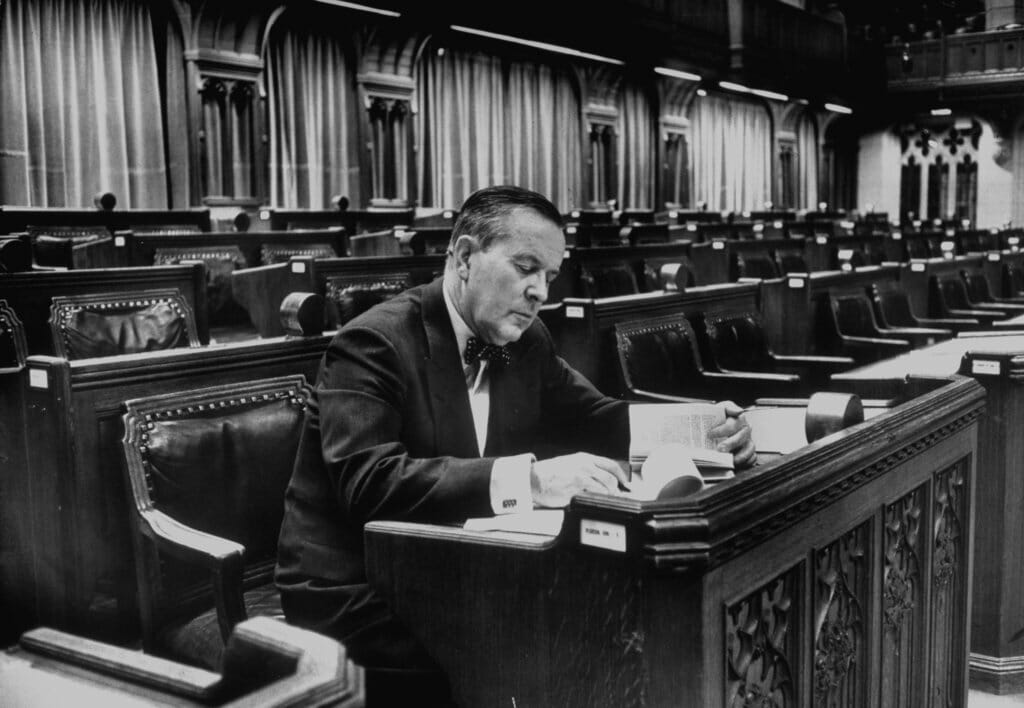The Canada Pension Plan at 50!
April 1, 2015

Lester Pearson was a remarkable Canadian.
We first came to know him as a proficient global statesman, skilled in the diplomacy of multilateralism. He assisted at the birth of the United Nations, invented the concept of peace-keeping, and won the Nobel Peace Prize. In 1963, he became Prime Minister of Canada.
Five years in that job, Mr. Pearson never once had a majority in Parliament, but still he led one of the most productive governments in Canadian history.
This past February, we celebrated the 50th anniversary of Canada’s Red Maple Leaf Flag — one of Mr. Pearson’s proudest accomplishments. Next year, we’ll mark the 50th anniversary of national medicare, another Pearson legacy.
And this week, the legislation that originally created the Canada Pension Plan (CPP) will turn 50 years old.
While they have tinkered with various private sector pension ideas, the Harper government has not been helpful in dealing with basic retirement income insecurity.
It passed the House of Commons on March 29th, 1965, was approved in the Senate on April 1st and received Royal Assent on April 3rd. The CPP and its Quebec counterpart came into effect on January 1st, 1966.
The stated purpose of the Canada Pension Plan and the Quebec Pension Plan (QPP) was to ensure all working Canadians have an opportunity to retire in dignity. They built on basic Old Age Security to achieve greater social justice linked to progress in the economy.
Established by federal-provincial agreement, CPP/QPP are mandatory contributory plans into which all employees, employers and the self-employed pay regular premiums. As such, CPP/QPP contributions are essential long-term investments in portable retirement incomes for a large portion of Canadians, supporting future living standards.
That sounds like common sense today, but 50 years ago it took extraordinary vision, diplomacy and persistence to get it done.
National Health and Welfare Minister, Judy LaMarsh, was a dynamo at the centre of the action. Quebec Premier Jean Lesage was pivotal, along with Ontario’s John Robarts. Stanley Knowles and Paul Martin Sr. were constant Parliamentary advocates. And Lester Pearson provided the driving determination.
At a key point in the negotiations, Premier Lesage made a bold “counter-proposal” which helped Mr. Pearson move all the provinces toward a more ambitious plan in the end, ensuring portability across the whole country.
The CPP/QPP was an historic accomplishment!
But by the 1990’s — with longer life expectancies, aging demographics and escalating unfunded liabilities — doubts had arisen about the future soundness of the CPP/QPP.
Would they run out of money? Were the benefits supportable? Was their administration strong, efficient and independent?
The plans clearly required major renovations to save them, and that would take federal-provincial consensus, which is always hard to get.
The stated purpose of the Canada Pension Plan and the Quebec Pension Plan (QPP) was to ensure all working Canadians have an opportunity to retire in dignity.
As part of a multi-pronged effort to restore fiscal integrity to the Government of Canada, then-federal Finance Minister Paul Martin Jr. decided to tackle the pension challenge. He found a key ally in the Provincial Treasurer of Alberta, Jim Dinning. Ontario Finance Minister Ernie Eves was also helpful. Together, they built the business case, the social consensus and the national momentum to rejuvenate the plans.
It’s an interesting historical footnote that saving the CPP earned strong support across Canada — except for provincial NDP governments in British Columbia and Saskatchewan, the federal NDP and Stephen Harper’s Reform/Alliance/Conservative Party.
Today, the CPP ranks as one of only a handful of successful public pension plans worldwide.
Its administration is competent and cost-effective. It’s a distinct fund, independently managed according to investment policies that are free from political interference.
It has a proven track-record as an international leader in the pension industry, generating world-class rates of return.
External actuaries have recently judged the CPP to be sound and secure for another 75 years (the maximum actuaries will go). And after other recent reforms, actuaries have also judged the QPP to be “viable for all generations”.
However, the CPP/QPP are labouring under one major limitation. The maximum regular benefit a contributor can receive is just over $12,000 per year. The average is just more than half that. Those amounts are far from sufficient to ensure retirees can maintain their quality of life, without other significant savings.
But the typical 35-year-old today is saving less than half of what their parents did at that age.
Three-quarters of those working in the private sector don’t have access to an employer-sponsored pension plan. And of those who are within 10 years of retirement, fewer than one-third have $100,000 or more set aside to sustain themselves. Another third have no retirement savings at all.
While they have tinkered with various private sector pension ideas, the Harper government has not been helpful in dealing with basic retirement income insecurity.
And this week, the legislation that originally created the Canada Pension Plan (CPP) will turn 50 years old.
They eliminated previous investment tools like Income Trusts, destroying about $25-billion in value formerly in the savings accounts of some 2-million Canadians. They are delaying eligibility for Old Age Security and the Guaranteed Income Supplement by two years, which will take nearly $30,000 from the lowest-income and most vulnerable seniors — most often women living alone. And Mr. Harper has vetoed every suggestion to upgrade the CPP/QPP.
All of which is to say: Canada has big challenges to face in the immediate future if we’re to honour Lester Pearson’s ambition of a fair, efficient, adequate system of retirement income for all Canadians.